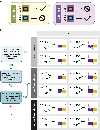Mixed selectivity: Cellular computations for complexity
- PMID: 38729151
- PMCID: PMC11257803
- DOI: 10.1016/j.neuron.2024.04.017
Mixed selectivity: Cellular computations for complexity
Abstract
The property of mixed selectivity has been discussed at a computational level and offers a strategy to maximize computational power by adding versatility to the functional role of each neuron. Here, we offer a biologically grounded implementational-level mechanistic explanation for mixed selectivity in neural circuits. We define pure, linear, and nonlinear mixed selectivity and discuss how these response properties can be obtained in simple neural circuits. Neurons that respond to multiple, statistically independent variables display mixed selectivity. If their activity can be expressed as a weighted sum, then they exhibit linear mixed selectivity; otherwise, they exhibit nonlinear mixed selectivity. Neural representations based on diverse nonlinear mixed selectivity are high dimensional; hence, they confer enormous flexibility to a simple downstream readout neural circuit. However, a simple neural circuit cannot possibly encode all possible mixtures of variables simultaneously, as this would require a combinatorially large number of mixed selectivity neurons. Gating mechanisms like oscillations and neuromodulation can solve this problem by dynamically selecting which variables are mixed and transmitted to the readout.
Keywords: brain; circuits; coding; cognition; computations; gating; mixed selectivity; neuromodulation; neuron; oscillations.
Copyright © 2024 The Authors. Published by Elsevier Inc. All rights reserved.
Conflict of interest statement
Declaration of interests K.M.T. and E.K.M. are members of the Neuron advisory board.
Figures




References
-
- Duncan J, and Miller EK (2002). Cognitive focus through adaptive neural coding in the primate prefrontal cortex. In Principles of frontal lobe function (Oxford University Press; ), pp. 278–291. 10.1093/acprof:oso/9780195134971.003.0018. - DOI
-
- Duncan J, and Miller EK (2013). Adaptive Neural Coding in Frontal and Parietal Cortex. In Principles of Frontal Lobe Function, Duncan J, Koechlin E, Stuss DT, and Knight RT, eds. (Oxford University Press; ), p. 0. 10.1093/med/9780199837755.003.0023. - DOI
Publication types
MeSH terms
Grants and funding
LinkOut - more resources
Full Text Sources

